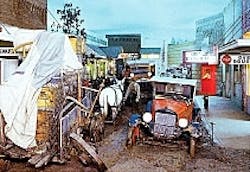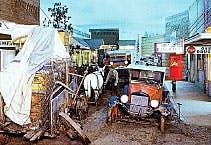East Texas Boomtown
The carefree, rural lifestyle of East Texas was changed dramatically during 1930-31 when Columbus Marion "Dad" Joiner, a 70-year-old wildcatter, discovered oil on the Daisy Bradford farm in Rusk County. In addition to Joiner's well, two extension wells-the Lou Della Crim and Lathrop-were successful, creating the largest oil field in the world at the time of the discovery. - Photo courtesy of East Texas Oil Museum.
East Texas field covers 140,000 acres across five counties: Rusk, Gregg, Smith, Upshur, and Cherokee. More than 32,000 wells were drilled in the field, with fewer than 500 dry holes. Today, 70 years later, the field has produced more than 5 billion bbl of oil, with an estimated 1 billion bbl still to be produced. By the time the field is depleted, some 86% of the original oil in place will have been recovered.
The story
Since August 1927, Joiner had been drilling on the Bradford farm and had drilled two dry holes. In May 1929, he spudded a third well, the Daisy Bradford No. 3, under the guidance of A.D. "Doc" Lloyd, geologist. In September 1930, a core from 3,536 ft was taken from the Bradford No. 3, which showed nearly a foot of oil pay sand. On Oct. 3, 1930, a production test was performed, resulting in a gusher that flowed 3,000-10,000 b/d.
Oil fever mounted when Bateman Oil Co. tested a well on the Lou Della Crim farm in Rusk County. On Dec. 28, 1930, the well blew out, flowing 22,000 b/d. The well was just 9 miles from Joiner's well. The initial phase of the "boom" was on its way on Jan. 26, 1931, when the J.K. Lathrop No. 1 well in Gregg County came in at 3,587 ft producing 18,000 b/d-27 miles north of the Joiner discovery well.
At the time, no one believed that there was any connection between the discoveries and chalked it up as a geological coincidence. It wasn't until several years later that geologists realized that all three wells tapped into an incredible deposit of oil in the Woodbine formation, which is a sandstone formation located at 3,650 ft, driven by an underground reservoir of saltwater moving from west to east.
Oil production
By early 1931, the population of most East Texas towns had doubled, and new communities sprang up, as leasehounds, oil promoters, roughnecks, and drillers quickly descended on these boomtowns seeking wealth. Ever-present rain contributed even more to the mayhem by turning dirt streets into marshlands, bottlenecking traffic in every direction.
Activity spread into Upshur, Smith, and Cherokee counties. New production increased rapidly, as drilling stepped up from 7 wells every 2 weeks to 100 wells/day. The first oil discovered sold for $1.10/bbl, but prices dropped to 15¢ as supply flooded the market. Early yield predictions for the field began at 1.2 billion bbl, but production tests of 290 wells that were allowed to flow wide open for 2 hr shot the potential open-flow production rate estimate up to 123,750,000 b/d. That would have depleted the field in a matter of days.
On Aug. 16, 1931, armed National Guardsmen were ordered into the area to keep peace in the local communities and to shut down the field until order could be restored to field operations. Subsequent legislation produced a market-demand law, confiscation law, refinery control and felony law, and the Connolly Hot Oil Act of 1935, which restored order and stability to the market.
Museum
Anyone interested in journeying back in time to the oil boom days can do so at the East Texas Oil Museum at Kilgore College, Kilgore Tex. The multimillion-dollar museum houses thousand of items donated from family treasures of persons who "lived the boom."
The heart of the museum is the diorama called Boomtown, USA. Entering through a leaded-glass door, visitors are transported to a life-sized 1930s oil boomtown, complete with stores, people, machinery, wagons, mules and other animals, and period vehicles mired in the muddied street (see photo). A visit to the theater brings back the historical film footage of the boom period while you experience a blowout gusher. You can even take "an elevator ride to the center of the earth" to see where the oil deposits lie.
Since its opening in 1980, more than 650,000 visitors have toured the facility. The museum describes it as a "tribute to the independent oil producers and wildcatters, to the men and women who dared to dream as they pursued the fruits of free enterprise."

